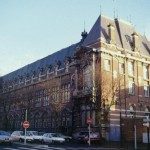About
Aspergillus fumigatus is an opportunistic pathogen than can cause a variety of diseases in immunocompromised individuals that range from allergies to severe pathologies such as invasive aspergillosis. This filamentous fungus has become the major aerial fungal pathogen of humans, killing over 200 000 people each year. The fungus grows in the soil where it sporulates abundantly to disseminate in the form of spores, which are the invasive form of the mould. In collaboration with the team of Jean-Paul Latgé (Aspergillus Unit, Institut Pasteur), we are interested in proteins from the hydrophobin family that form functional amyloid fibres on the spores cell-wall, as well as in their interactions with mayor cell wall components, to get a better understanding of the fungal cell wall.
Hydrophobins are proteins with remarkable physicochemical properties produced by filamentous fungi in a soluble form. These proteins self-assemble at hydrophobic/hydrophilic or air/water interfaces to form an amphipatic layers with a rodlet morphology that shows the hallmarks of amyloid fibres. Hydrophobins are thus functional amyloids. The cell wall of A. fumigatus spores is covered by a protective coat formed by the RodA hydrophobin. This hydrophobic coat facilitates the air-dispersal of the spores, protects spores from desiccation and renders conidia inert relative to the innate and adaptive immune systems. A. fumigatus cell wall contains two close homologues of RodA, called RodB and RodC, of unknown function. We work on the structure of the soluble form of the Rod hydrophobins, their mechanism of self-assembly into insoluble rodlets, their amyloidogenic determinants, the structure of the rodlets and on their interactions with major cell wall components such as melanin, alfa- and beta-(1,3) glucans, chitin and galactomannan.




